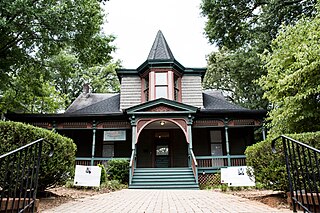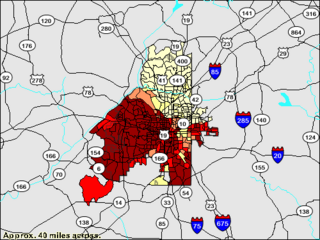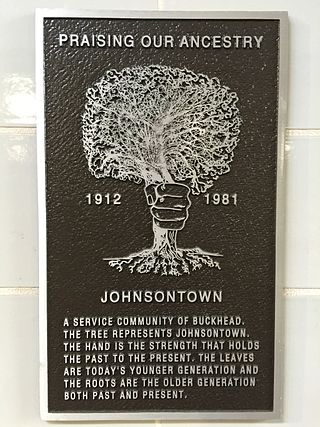Related Research Articles

Currier and Ives was a New York City-based printmaking business operating from 1835 to 1907. Founded by Nathaniel Currier, the company designed and sold inexpensive hand-painted lithographic works based on news events, views of popular culture and Americana. Advertising itself as "the Grand Central Depot for Cheap and Popular Prints", the corporate name was changed in 1857 to "Currier and Ives" with the addition of James Merritt Ives.

The Sweet Auburn Historic District is a historic African-American neighborhood along and surrounding Auburn Avenue, east of downtown Atlanta, Georgia, United States. The name Sweet Auburn was coined by John Wesley Dobbs, referring to the "richest Negro street in the world," one of the largest concentrations of African-American businesses in the United States.

The Old Fourth Ward, often abbreviated O4W, is an intown neighborhood on the eastside of Atlanta, Georgia, United States. The neighborhood is best known as the location of the Martin Luther King Jr. historic site.

Adair Park is a historic residential neighborhood located southwest of downtown Atlanta. It has the form of a left curly bracket, bordered by the MARTA north–south rail line on the northwest, the BeltLine trail on the southwest and Metropolitan Parkway on the east. Historically Adair Park also included the area from Metropolitan Parkway to McDaniel Street on the east, but the city now considers that area part of the Pittsburgh neighborhood.
Black people have been portrayed in comics since the medium's beginning, with their portrayals often the subject of controversy. Mainstream comic publishing companies have had a historical trend of being predominantly white and male, reflecting the lack of representation and inaccurate depictions of Black people in comics. The integration of black characters in mainstream and superhero comics has endured various obstacles and challenges. Critics have noted that black men and women have historically often been portrayed as jungle or ghetto stereotypes, and as sidekicks as opposed to primary characters. Occiasionally, comic book creators would lampshade stereotypes, lack of representation and emphasize social injustices. In recent years, with the integration of more Black people in mainstream comic writing rooms as well as the creation of comics on digital platforms has changed the representation and portrayals of Black people in comics and has started to reflect the complexities of Black people across the diaspora.
Riverside is an intown neighborhood located on the Upper Westside of Atlanta. It is so named because it is situated along the Chattahoochee River.

The Big Bethel AME Church a black church on Sweet Auburn in Atlanta, Georgia, United States.

Boulevard is a street in and, as a corridor, a subdistrict, of the Old Fourth Ward neighborhood of Atlanta, Georgia. The street runs east of, and parallel to, Atlanta's Downtown Connector. It begins at Ponce de Leon Avenue in the north, passing through the Old Fourth Ward, Cabbagetown, and Grant Park, and forming the border between Chosewood Park on the west and Boulevard Heights and Benteen Park to the east. It ends at McDonough Boulevard in the south, at the Federal Penitentiary.
Buttermilk Bottom, also known as Buttermilk Bottoms or Black Bottom, was an African-American neighborhood in central Atlanta, centered on the area where the Atlanta Civic Center now stands in the Old Fourth Ward. It was considered a slum area, having unpaved streets and no electricity.
In 1994 the Atlanta Housing Authority, encouraged by the federal HOPE VI program, embarked on a policy created for the purpose of comprehensive revitalization of severely distressed public housing developments. These distressed public housing properties were replaced by mixed-income communities.

The Hammonds House Museum is a fine art museum for African American art, established in 1988 and located in the West End neighborhood of Atlanta, Georgia, United States. The mission of the museum is to preserve, display, interpret and increase awareness about visual artists of African descent. The museum has a permanent collection, as well as offering temporary exhibitions and art classes.

Black Atlantans form a major population group in the Atlanta metropolitan area, encompassing both those of African-American ancestry as well as those of recent Caribbean or African origin. Atlanta has long been known as a center of Black entrepreneurship, higher education, political power and culture; a cradle of the Civil Rights Movement.

Johnsontown was a settlement in what is now the Buckhead Community of Atlanta, Georgia which was located on the present site of the Lenox MARTA station. It was settled by African Americans in 1912. Until 1982 approximately thirty families lived here on 23-foot (7.0 m) by 143-foot (44 m) lots, until the land was acquired to build the rapid transit station.
Blandtown is a neighborhood of the West Midtown area of Atlanta, Georgia. It is located along either side of Huff Road from Howell Mill Road west to Marietta Blvd. It was one of the first black settlements around Atlanta after the Civil War, named for a Black man who owned property. As a community it declined from the 1950s through 1990s, following racially motivated rezoning and a general flight from cities to suburbs. It now forms part of the West Midtown area, a rapidly developing part of Atlanta known for its home furnishings stores, new apartment and condo complexes, restaurants and bars.

Washington–Rawson was a neighborhood of Atlanta, Georgia. It included what is now Center Parc Stadium and the large parking lot to its north, until 1997 the site of Atlanta–Fulton County Stadium, as well as the I-20-Downtown Connector interchange. Washington and Rawson streets intersected where the interchange is today. To the northwest was Downtown Atlanta, to the west Mechanicsville, to the east Summerhill, and to the south Washington Heights, now called Peoplestown.
The APEX Museum is a museum of history presented from the black perspective. It is located on Auburn Avenue in the Sweet Auburn historic district of Atlanta, Georgia.
Dixie Hills is a historic neighborhood of northwest Atlanta with a population of 1,756 (2010).

Darktown, published in 2016, is the fourth novel by American author Thomas Mullen. Its first sequel, Lightning Men, was published in September 2017. In 2020 Midnight Atlanta, the second sequel, was published.

Atlanta's Berlin Wall, also known as the Peyton Road Affair or the Peyton Wall, refers to an event during the civil rights movement in Atlanta, Georgia, United States, in 1962. On December 17 of that year, the government of Atlanta, led by mayor Ivan Allen Jr., erected a barricade in the Cascade Heights neighborhood, mostly along Peyton Road, for the purposes of dissuading African Americans from moving into the neighborhood. The act was criticized by many African American leaders and civil rights groups in the city, and on March 1 of the following year the barricade was ruled unconstitutional and removed. The incident is seen as one of the most public examples of white Americans' fears of racial integration in Atlanta.

Darktown Comics is a series of Currier and Ives prints first produced in the 1870s that depicted racist vignettes ostensibly portraying a Black American town. It was a perennial bestseller for the New York-based firm, with some prints selling 73,000 copies via pushcarts and country stores, and all of them becoming bestsellers. The series represented one-third of Currier and Ives' production by 1884.
References
- ↑ Barrelhouse Words: A Blues Dialect Dictionary By Stephen Calt, p.69
- ↑ The separate city: Black communities in the Urban South, 1940-1968, p.130, Christopher Silver, John V. Moeser
- ↑ "Lithograph, "The Darktown Fire Brigade: Under Full Steam"". National Museum of American History. Retrieved 2021-02-15.
- ↑ Le Beau, Bryan (Spring 2000). "African Americans in Currier and Ives's America: The darktown series". Journal of American and Comparative Cultures . ProQuest 200582642 . Retrieved 2021-02-15.
- ↑ Benti, Diann (2019-10-15). "Lucrative Racism". AHPCS. Retrieved 2021-02-15.
- ↑ Kartheus, Wiebke (2019-04-07). ""Let the World Know You Are Alive": May Alcott Nieriker and Louisa May Alcott Confront Nineteenth-Century Ideas about Women's Genius". American Studies Journal. Retrieved 2021-02-15.
- ↑ The separate city: Black communities in the Urban South, 1940-1968, p.130, Christopher Silver, John V. Moeser